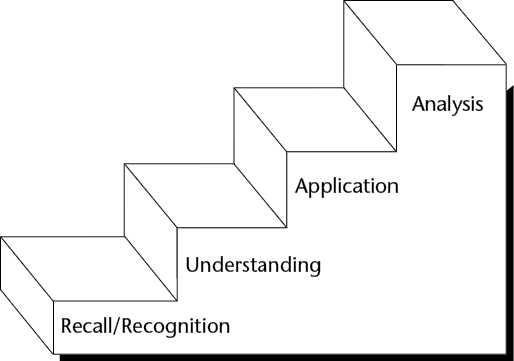
The NCLEX-PN® exam does not just test your nursing knowledge: It assumes that you have a body of knowledge and you understand the material because you have graduated from nursing school. So what does the NCLEX-PN® exam test? The NCLEX-PN® exam primarily tests your nursing decisions. It tests your ability to think critically and solve problems.
What does the term critical thinking mean? Critical thinking is problem solving that involves thinking creatively. It requires that the practical/vocational nurse:
You successfully solve problems every day in the clinical area. You are probably comfortable with this concept when actually caring for clients. Although you’ve had lots of practice critically thinking in the clinical area, you may have had less practice critically thinking your way through test questions. Why is that?
During nursing school, you take exams developed by nursing instructors to test a specific body of content. Many of these questions are at the knowledge level. This involves recognition and recall of ideas or material that you read in your nursing textbooks and discussed in class. This is the most basic level of testing. Figure 1 illustrates the different levels of questions on nursing exams.
The following is an example of a knowledge-based question you might have seen in nursing school.
The question restated is, “What is a common complication of a liver biopsy?” You may or may not remember the answer. So, as you look at the answer choices, you hope to see an item that looks familiar. You do see something that looks familiar: “Hemorrhage.” You select the correct answer based on recall or recognition. The NCLEX-PN® exam rarely asks passing questions at the recall/recognition level.

In nursing school, you are also given test questions written at the comprehension level. These questions require you to understand the meaning of the material. Let’s look at this same question written at the comprehension level.
The question restated is, “Why does hemorrhage occur after a liver biopsy?” In order to answer this question, the nurse must understand that the liver is a highly vascular organ. The portal vein and the hepatic artery join in the liver to form the sinusoids that bathe the liver in a mixture of venous and arterial blood.
The NCLEX-PN® exam asks few minimum-competency questions at the comprehension level. It assumes you know and understand the facts you learned in practical/vocational nursing school.
Minimum-competency NCLEX-PN® exam questions are written at the application and/or analysis level. Remember, the NCLEX-PN® exam tests your ability to make safe judgments about client care. Your ability to solve problems is not tested with questions at the recall/recognition or comprehension level.
Let’s look at this same question written at the application level.
Can you select an answer based on recall or recognition? No. Let’s analyze the question and answer choices.
The question is: What is a complication of a liver biopsy? In order to begin to analyze this question, you must know that hemorrhage is the major complication. However, it’s not listed as an answer. Can you find hemorrhage in one of the answer choices?
ANSWERS:
Ask yourself, “Which is the best indicator of hemorrhage?” Abdominal distention or a change in vital signs? Abdominal distention can be caused by liver disease. The correct answer is (3).
This question tests you at the application level. You were not able to answer the question by recalling or recognizing the word hemorrhage. You had to take information you learned (hemorrhage is the major complication of a liver biopsy) and select the answer that best indicates hemorrhage. Application involves taking the facts that you know and using them to make a nursing judgment. You must be able to answer questions at the application level in order to prove your competence on the NCLEX-PN® exam.
Let’s look at a question that is written at the analysis level.
Many students panic when they read this question because they can’t immediately recall any diet restriction required by a client taking haloperidol. Because students can’t recall the information, they assume that they didn’t learn enough information. Analysis questions are often written so that a familiar piece of information is put in an unfamiliar setting. Let’s think about this question.
What type of diet do you choose for a client receiving haloperidol? In order to begin analyzing this question, you must first recall that haloperidol is an antipsychotic medication used to treat psychotic disorders. There are no diet restrictions for clients taking haloperidol. Because there are no diet restrictions, you must problem-solve to determine what this question is really asking. Based on the answer choices, it is obviously a diet question. What kind of diet should you choose for this client? Because you have been given no other information, there is only one type of diet that can be considered: a regular balanced diet. This is an example of taking the familiar (a regular balanced diet) and putting it into the unfamiliar (a client receiving haloperidol). In this question, the critical thinking is deciding what this question is really asking.
QUESTION: “What is the most balanced regular diet?”
ANSWERS:
Which is the better answer choice: (1) or (2)? Dill pickles are high in sodium, so the correct answer is (2).
Choosing the menu that best represents a balanced diet is not a difficult question to answer. The challenge lies in determining that a balanced diet is the topic of the question. Note that answer choices (1) and (2) are very similar. Because the NCLEX-PN® exam is testing your discretion, you will be making decisions between answer choices that are very close in meaning. Don’t expect obvious answer choices.
These questions highlight the difference between the knowledge/comprehension-based questions that you may have seen in nursing school, and the application/analysis-based questions that you will see on the NCLEX-PN® exam.